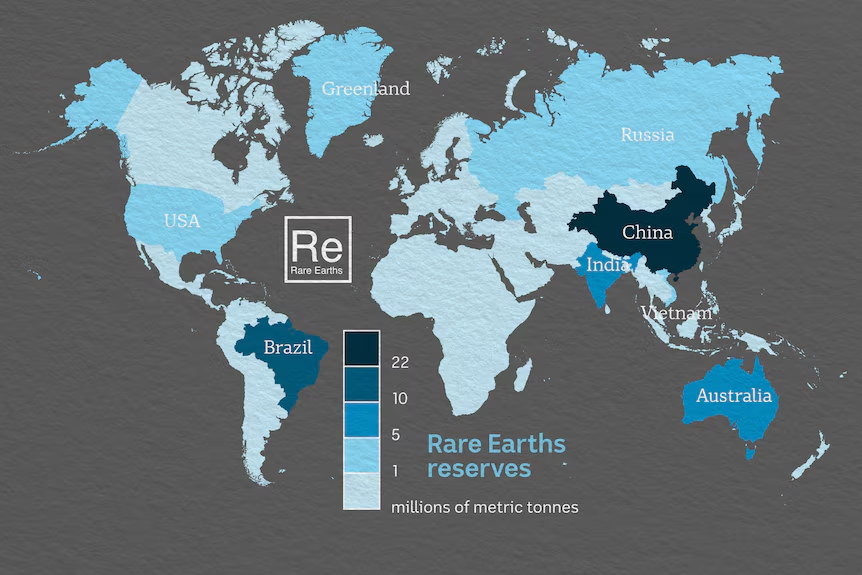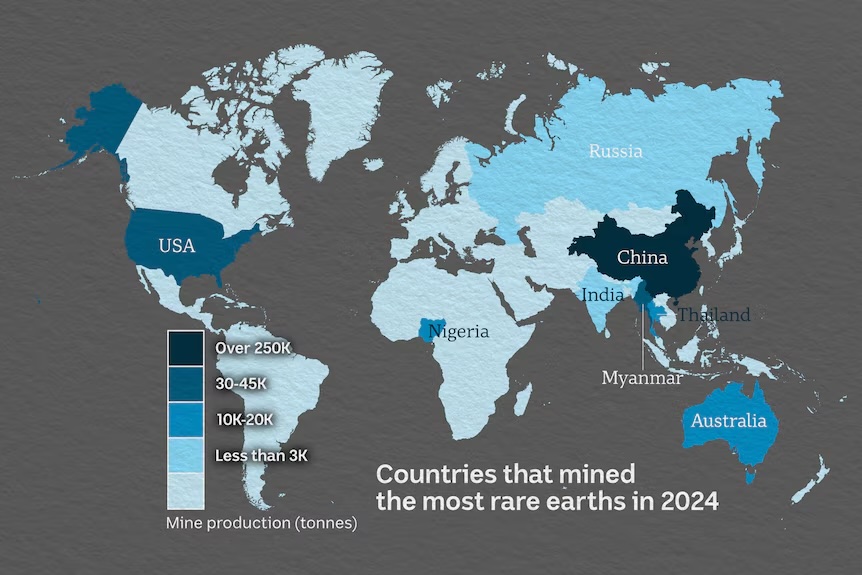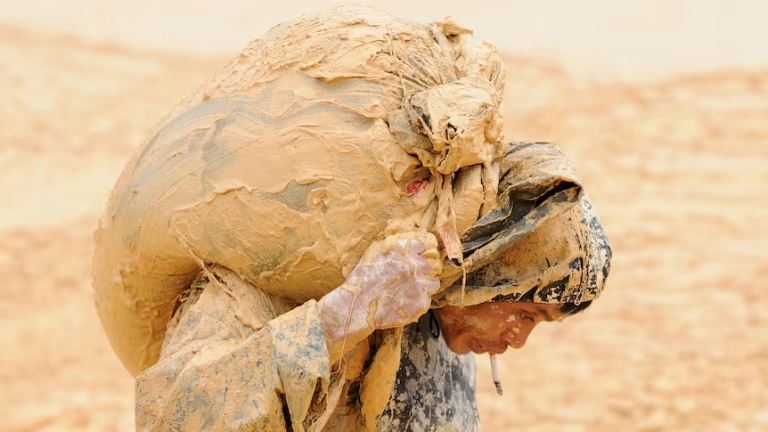Unlike the name suggests, rare earths are not very rare at all.
Many countries — including Australia — are rich in the critical minerals that have become vital for modern technology.
Rare earths are used to manufacture everything from smartphones and electric vehicles to wind turbines, weapons and medical equipment.
Although the minerals can be found in abundance in some countries, there is still only one main supply chain powerhouse: China.
This is how rare earths are mapped around the world, and why being big on reserves may not mean big business.
Not rare, but critical
In Australia, 31 minerals are considered critical, including lithium, magnesium and zirconium.
Rare earths are a subset of critical minerals, made up of about 17 elements on the periodic table.
What makes rare earths unique is their magnetic characteristics, which have become critical in everyday technologies and emerging fields such as green energy.
“These permanent rare earth magnets, they’re incredible things,” John Mavrogenes, professor of economic geology at the Australian National University, said.
“They can produce energy in a wind turbine … they run your electric car, and they run escalators, elevators and refrigerators.
Rare earth reserves: Top 8 countries
China has an estimated 44 million metric tonnes of reserves compared with 5.7 million in Australia and 1.9 million in the United States.

There were 110 million tonnes of rare earth deposits worldwide in 2024, according to estimates from the US Geological Survey.
Nearly half of the world’s total known reserves of rare earths are in China.
Brazil follows with about 21 million metric tonnes, with India and Australia ranked third and fourth for reserves by country.
Although there is an abundance of the elements in the Earth’s crust, they tend to be spread thin, and are often mixed together with other minerals.
So larger deposits are difficult to find and costly to extract.
The real rarity comes in the complex process to separate the rare earths into the materials needed to produce permanent magnets.
Professor Mavrogenes said this was why looking at reserves did not paint the full picture.
“We don’t know yet if they’ll be profitable,” he said.
“They should have an asterisk after them until you really do the work to see: Can you get these minerals out? Can you process them? Can you take them to market? It is a very difficult, complex area.”
The countries mining the most rare earths
Not only does China have the world’s largest rare earth reserves, it also leads in production and processing, generating about 270,000 metric tonnes in 2024.

The US and Myanmar were in second and third place, having extracted and processed 45,000 and 31,000 tonnes, respectively, last year.
Australia was the fourth-largest, alongside Nigeria and Thailand, mining 13,000 tonnes, according to data from the US Geological Survey.
China accounts for about 70 per cent of rare earth mining, 90 per cent of separation and processing, and 93 per cent of magnet manufacturing, according to analysis from the Centre for Strategic and International Studies (CSIS).
“Not only do they have big rare earth deposits that they’re mining, but they’re going all the way through to separating the rare earths, then metallising them, then making all the products, including the most important — the magnets,” Professor Mavrogenes said.
“Both Germany and Japan have the technology to make magnets, and they do make magnets, except they don’t make as many as they could because they can buy them cheaper from China.”
Warren Pearce, chief executive of Australia’s Association of Mining and Exploration Companies, said China’s dominance was “overwhelming”.
Mining was not necessarily the issue with rare earths, Professor Mavrogenes said.
Rare earths could contain radioactive components, and extracting critical minerals had a considerable environmental footprint.
Experts say that even countries with a strong record of water management must innovate to meet the water needs of rare earth processing.
Professor Mavrogenes said these were factors for many countries looking to tap into rare earth reserves.
“Some of them might be really good, really high grade, but are they going to be able to afford to mine them? Are they willing to make the environmental sacrifice for it?” he said.
Outside China, the other significant deposits are found in the Mountain Pass mine in the US and Mount Weld in Western Australia.
But for both, the vast majority of their raw minerals are still exported as domestic processing and refining remain limited.
At Mount Weld, ore is concentrated into a rare earth oxide that is sent to Malaysia for separation into various rare earths.
Australia’s industry boost
Analysts at CSIS said Australia, Brazil, South Africa, Saudi Arabia, Japan, and Vietnam all had initiatives and investments underway to bolster key rare earth mining, processing, and research and development.
Australia’s Critical Minerals Strategy sets out a plan to move from simply mining and extracting the minerals to refining and processing them.
There are hopes that a historic rare earth and critical minerals processing agreement signed by the US and Australia this week will speed projects up.
Mr Pearce said Australia had been ahead of other countries, but was still “a long, long way behind China”.
“The United States stepping up and really making a major commitment today is really, really welcome and will enable us to actually start building these projects knowing that there’s a future for them,” he said after the agreement was signed.
The multi-billion-dollar minerals deal, inked when Australian Prime Minister Anthony Albanese met US President Donald Trump at the White House, was designed for “critical mineral and energy dominance”.
The move follows Beijing’s new requirement for foreign companies to get approval from the Chinese government to export magnets containing even trace amounts of rare earth materials that originated from China, or were produced with Chinese technology.
“They’ve [China] been really effective in developing that IP and technology and not sharing it … being supported by US manufacturers and processing companies, there’s an ability to access technology and expertise to actually build that,” Mr Pearce said.
“We’ve always needed a bigger partner.”


